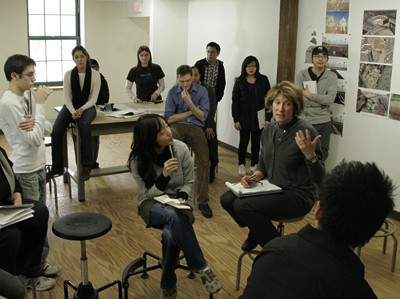Architecture studio to visit 2010 World Cup sites in Johannesburg, South Africa
By Daniel Aloi
As Johannesburg, South Africa, prepares for the 2010 FIFA World Cup soccer tournament, a Cornell Master in Architecture program studio is studying how architects can address the opportunities and challenges a global event presents for its host country.
Students are taking their speculative design projects to Johannesburg this month, where they will get a firsthand view of the city's preparations and meet with city development officials.
"It's interesting to see the various forces at play in the run-up to the event," said Andrea Simitch, who teaches the studio with fellow associate professor of architecture John Zissovici and Jeremy Foster, visiting critic in architecture and city and regional planning.
Students were asked to consider "the relationship between the immediate effect and the afterlife" of the event on its surroundings, and extensively researched South Africa and similar large-scale events, including world's fairs and Olympics.
"They are finding amazing things in their research," said Foster, who was raised in South Africa.
"We're trying to advance the proposition of an alternative form of practice that opens up architectural discourse to broader issues, [and] the notion of collaborative practice in the studio, as informed by various areas of expertise," such as landscape architecture and planning, Simitch said.
Students are encouraged to work collaboratively and consider issues including event-based urbanism, accessibility of the World Cup to all strata of South African society, and the infrastructural web connecting rural and urban economies with capital-intensive projects.
"Infrastructure is a big deal in Johannesburg, because it's a city of unequal development," Foster said. "The transportation system is extremely politicized and uneven. The goal is to make [the event] accessible to everyone. Access to the city in both the physical and cultural sense is integral to the project of transformation."
The studio also explores the role of media and of related events in shaping urban identities and cultural practices, such as the branding of soccer as a global sport and the identity South Africa will present as an economic, political and cultural entity during the World Cup.
"For the biggest event in South Africa, I was interested in how to make national identity a brand – for the World Cup, every activity is broadcast to the world," said master's candidate Namsuk Oh. "My strategy is [that] the cityscape [of Johannesburg] bears the national image."
During their week in South Africa, students will visit World Cup facilities including the actual sites of their projects, three proposed fan parks where up to 10,000 people at each site can watch the matches on large screens. Students will also have their projects reviewed by architects, faculty and students at the University of Witwatersrand.
"2010 is a fortuitous opportunity," Simitch said. "We are hoping to see it as a beginning of a series of studios in sub-Saharan Africa."
Previous Cornell architecture programs in Africa include a 2007 master's program studio studying the informal settlements in Nairobi, Kenya, and a design studio two years ago that focused on the first national park to consciously celebrate post-apartheid identity, conceived of as a transnational territory linking South Africa to neighboring countries.
"It was the same idea – architects being agents of social transformation," Foster said.
Media Contact
Get Cornell news delivered right to your inbox.
Subscribe